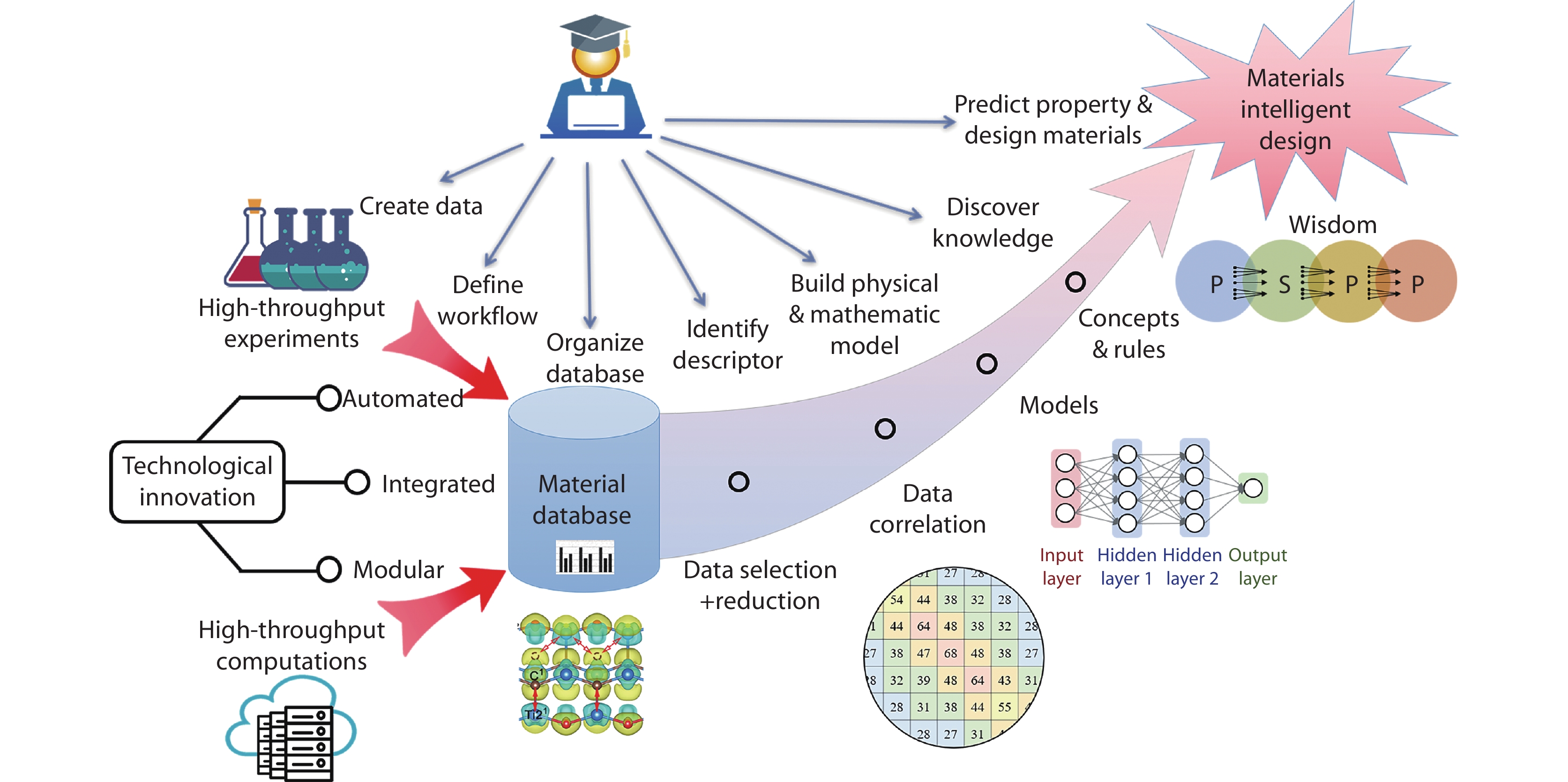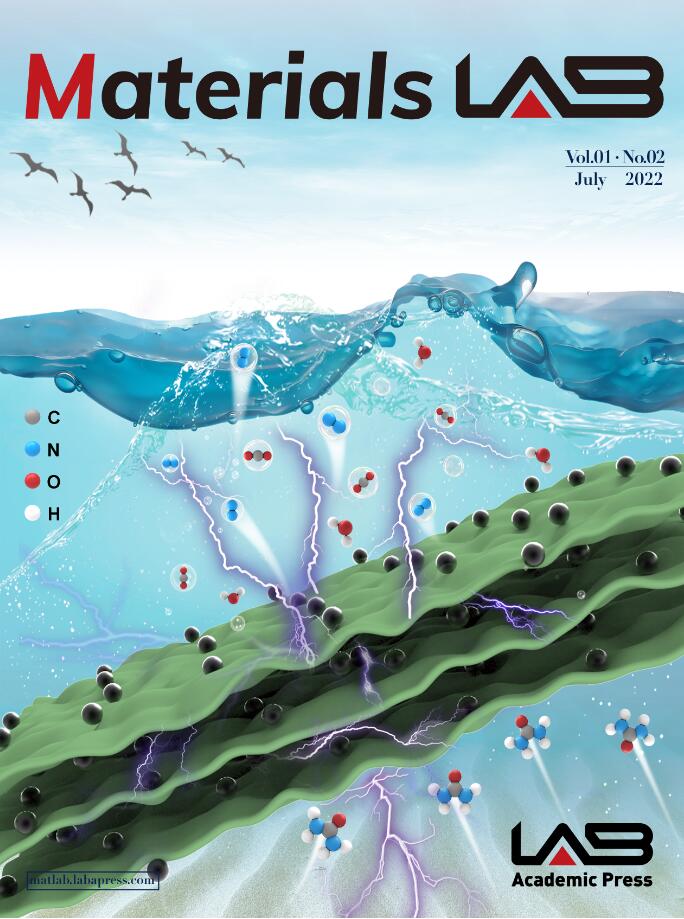| Citation: | Ruifeng Zhang, Tengfei Xu, Bonan Yao, Zhaorui Liu. Perspectives in the New Era of Materials Intelligent Design. Materials Lab 2022, 1, 220017. doi: 10.54227/mlab.20220017 |
Perspectives in the New Era of Materials Intelligent Design
Published as part of the Virtual Special Issue “Beihang University at 70”
-
Abstract
The launching integrated computational materials engineering (ICME) and materials genome engineering (MGE) has led the transformation of empirical and theoretical design paradigm into the rational computational one that further provides the basis for the data-driven design paradigm by integrating the high-throughput techniques in experiments and computations, the big data science with general principles, the informatics with knowledge discovery based on data mining and machine learning, and ultimately enabling the possibility of materials intelligence design (MID) via artificial intelligence. In this perspective article, we highlight the intelligent solution to acquire the processing-structure-property-performance relationship of multilevel-structured materials by emphasizing modularization, automation, standardization, integration and intelligence, following the hierarchical relationship of data, information, knowledge and wisdom, which is essentially different from the past empirical, theoretical and computational paradigms. The new era of MID is expected to fundamentally reform the material innovation mode through an integrated infrastructure guided by novel concepts that is radically distinguished from the way of thinking and doing in the past, providing a perspective scientific vision and direction for future materials design.
-

-
References
1. D. L. McDowell and G. B. Olson, Sci. Model. and Simul., 2008, 15, 207 2. National Science and Technology Council Committee on Technology Subcommittee on the Materials Genome Initiative, Materials Genome Initiative Strategic Plan, USA, June 2014. 3. National Research Council, Integrated Computational Materials Engineering: A Transformational Discipline for Improved Competitiveness and National Security, The National Academies Press, USA, 2008. 4. R. Lesar, Introduction to Computational Materials Science: Fundamentals to Applications, Cambridge University Press, UK, 2013. 5. T. Hey, S. Tansley, and K. Tolle, The Fourth Paradigm: Data-Intensive Scientific Discovery, Microsoft Research Press, USA, 2009. 6. S. R. Kalidindi, Int. Mater. Rev., 2015, 60, 150 7. A. Agrawal and A. Choudhary, APL Mater., 2016, 4, 053208 8. G. Ceder and K. Persson, Sci. Am., 2013, 309, 36 9. H. Wang, X. D. Xiang and L. T. Zhang, Sci. Technol. Rev., 2018, 36, 15 10. A. Jain, S. P. Ong, G. Hautier, W. Chen, W. D. Richards, S. Dacek, S. Cholla, D. Gunter, D. Skinner, G. Ceder and K. A. Persson, APL Mater., 2013, 1, 011002 11. S. Curtarolo, W. Setyawan, G. L. Hart, M. Jahnatek, R. V. Chepulskii, R. H. Taylor, S. Wang, J. Xue, K. Yang, O. Levy and M. J. Mehl, Comput. Mater. Sci., 2012, 58, 218 12. Z. R. Liu, B. N. Yao, R. F. Zhang, Comput. Mater. Sci., 13. S. Kirklin, J. E. Saal, B. Meredig, A. Tompson, J. W. Doak, M. Aykol, S. Ruhl and C. Wolverton, npj Comput. Mater., 2015, 1, 1 14. A. Zakutayev, N. Wunder, M. Schwarting, J. D. Perkins, R. White, K. Munch, W. Tumas and C. Phillips, Sci. Data, 2018, 5, 1 15. L. M. Ghiringhelli, J. Vybiral, S. V. Levchenko, C. Draxl, and M. Scheffler, Phys. Rev. Lett., 2015, 114, 105503 16. D. J. Livingstone, Artificial neural networks: Methods and Applications, Humana Press, USA, 2008. 17. J. Behler, Chem. Rev., 2021, 121, 10037 18. G. L. W. Hart, T. Mueller, C. Toher, and S. Curtarolo, Nat. Rev. Mater., 2021, 6, 730 -
Rights and permissions
This is an open access article under the terms of the Creative Commons Attribution License, which permits use, distribution and reproduction in any medium, provided the original work is properly cited.
Information
Article Metrics
-
Figure 1.
The unified research and design strategy of future material design, which brings a new era of MID by integrating the high-throughput techniques, data science, informatics with knowledge discovery and the artificial intelligence to acquire the processing-structure-property-performance (PSPP) relationship.[5-7]

 Ruifeng Zhang is a full professor of the School of Materials Science and Engineering at Beihang University, China. He obtained Ph.D. in Materials Science from Tsinghua University in 2005 with honors of “Excellent PhD Graduate” and “Excellent PhD Thesis” of the university, and received Alexander von Humboldt Fellowship (Germany) and Los Alamos Director’s Postdoctoral Fellowship (USA). He has published over 150 papers in international journals such as Chem. Rev., Phys. Rep., PNAS, PRL, Adv. Mater., Acta. Mater. with >4000 citations (h-index=43). Several software in computational materials science are released in public, e.g. MiedCalc; AELAS, ADAIS, PNADIS; SPaMD, EAPOT, AACSD, AADIS.
Ruifeng Zhang is a full professor of the School of Materials Science and Engineering at Beihang University, China. He obtained Ph.D. in Materials Science from Tsinghua University in 2005 with honors of “Excellent PhD Graduate” and “Excellent PhD Thesis” of the university, and received Alexander von Humboldt Fellowship (Germany) and Los Alamos Director’s Postdoctoral Fellowship (USA). He has published over 150 papers in international journals such as Chem. Rev., Phys. Rep., PNAS, PRL, Adv. Mater., Acta. Mater. with >4000 citations (h-index=43). Several software in computational materials science are released in public, e.g. MiedCalc; AELAS, ADAIS, PNADIS; SPaMD, EAPOT, AACSD, AADIS. 

 DownLoad:
DownLoad:

